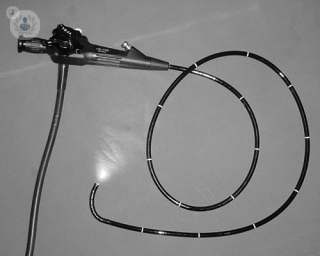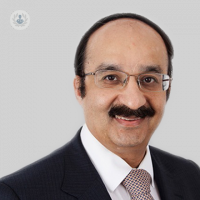What is an ERCP?
Endoscopic retrograde cholangiopancreatography (ERCP) is an invasive diagnostic and treatment procedure. ERCP combines the use of endoscopy and fluoroscopy to diagnose and treat problems of the pancreatic or biliary ductal systems.

What does an ERCP involve?
The procedure is performed in three main steps:
- You will be lying down on your left side, on the fluoroscope flatbed;
- You will be given intravenous sedation;
- An endoscope with a camera on one of its ends will be passed through your mouth and oesophagus to your duodenum. The doctor will be able to see the images projected by the camera on a screen. The endoscope will also inject a contrast medium which will allow for a fluoroscopy to be carried out as well.
What is ERCP used for?
You may need an ERCP if:
- You have already done other tests such as an ultrasound or a CT scan and you have a confirmed diagnosis of bile duct stones or pancreatic cancer;
- You have obstructive jaundice: when the flow of bile is obstructed and cannot reach the duodenum, a pigment known as bilirubin remains in the bloodstream, causing obstructive jaundice;
- You have pancreatitis, which can be either acute or chronic. In the first case, the symptoms show up suddenly while in the second case the inflammation shows up progressively; pancreatitis becomes more severe, causing the destruction of the pancreas itself;
- You have kidney stones or gallstones;
- Benign or malignant pancreatic cancer, which could be caused by a proliferation of exocrine or endocrine cells within the pancreas;
- You’re suffering from pancreas divisum, that is, an anomaly of the pancreas where the pancreatic duct is divided into two ducts instead of being a single duct;
- You need to take a pancreatic tissue sample or bile duct cells sample for a biopsy. This is also extremely helpful when it comes to confirming a diagnosis of pancreatic cancer or cancer of the bile ducts.
This procedure can also be used as a treatment for:
- Eliminating bile duct stones;
- Doing a biliary stent, that is, putting a stent inside the bile duct to treat an obstruction or narrowing;
- Treating a bile duct stricture;
How can I prepare for an ERCP?
Here is what you can do to prepare for an ERCP:
- Talk to your GP in order to have your medical, clinical and family history sorted out in advance;
- Do a blood test, an ECG and take your blood pressure;
- If you are on certain medications, you may need to go off of those a few days before the procedure;
- As a precautionary measure, you may need to get started on antibiotics;
- Do not eat anything for at least eight hours before the procedure.
What does it feel like during an ERCP?
Should you be under local anaesthetics, it may feel like you can’t breathe when the endoscope is going down your oral cavity - rest assured though, the air flow won’t be blocked in any way.
10-21-2015 05-30-2023ERCP
Dr Mark Austin - Gastroenterology
Created on: 10-21-2015
Updated on: 05-30-2023
Edited by: Sophie Kennedy
What is an ERCP?
Endoscopic retrograde cholangiopancreatography (ERCP) is an invasive diagnostic and treatment procedure. ERCP combines the use of endoscopy and fluoroscopy to diagnose and treat problems of the pancreatic or biliary ductal systems.

What does an ERCP involve?
The procedure is performed in three main steps:
- You will be lying down on your left side, on the fluoroscope flatbed;
- You will be given intravenous sedation;
- An endoscope with a camera on one of its ends will be passed through your mouth and oesophagus to your duodenum. The doctor will be able to see the images projected by the camera on a screen. The endoscope will also inject a contrast medium which will allow for a fluoroscopy to be carried out as well.
What is ERCP used for?
You may need an ERCP if:
- You have already done other tests such as an ultrasound or a CT scan and you have a confirmed diagnosis of bile duct stones or pancreatic cancer;
- You have obstructive jaundice: when the flow of bile is obstructed and cannot reach the duodenum, a pigment known as bilirubin remains in the bloodstream, causing obstructive jaundice;
- You have pancreatitis, which can be either acute or chronic. In the first case, the symptoms show up suddenly while in the second case the inflammation shows up progressively; pancreatitis becomes more severe, causing the destruction of the pancreas itself;
- You have kidney stones or gallstones;
- Benign or malignant pancreatic cancer, which could be caused by a proliferation of exocrine or endocrine cells within the pancreas;
- You’re suffering from pancreas divisum, that is, an anomaly of the pancreas where the pancreatic duct is divided into two ducts instead of being a single duct;
- You need to take a pancreatic tissue sample or bile duct cells sample for a biopsy. This is also extremely helpful when it comes to confirming a diagnosis of pancreatic cancer or cancer of the bile ducts.
This procedure can also be used as a treatment for:
- Eliminating bile duct stones;
- Doing a biliary stent, that is, putting a stent inside the bile duct to treat an obstruction or narrowing;
- Treating a bile duct stricture;
How can I prepare for an ERCP?
Here is what you can do to prepare for an ERCP:
- Talk to your GP in order to have your medical, clinical and family history sorted out in advance;
- Do a blood test, an ECG and take your blood pressure;
- If you are on certain medications, you may need to go off of those a few days before the procedure;
- As a precautionary measure, you may need to get started on antibiotics;
- Do not eat anything for at least eight hours before the procedure.
What does it feel like during an ERCP?
Should you be under local anaesthetics, it may feel like you can’t breathe when the endoscope is going down your oral cavity - rest assured though, the air flow won’t be blocked in any way.


What should I expect from an ERCP?
By Dr Gavin Johnson
2024-11-18
In those with bile duct problems, and sometimes pancreatic problems, a procedure called ERCP may be recommended as a course of action. Gastroenterologist Dr Gavin Johnson is an expert in the procedure, and here he explains exactly what it is, and what it's used for. See more


Why am I having an ERCP?
By Dr Deepak Joshi
2024-11-17
If you are troubled by abdominal pain, weight loss or jaundice your doctor may suggest you undergo an ERCP to figure out what's going on and treat it directly. Dr Deepak Joshi explains what this procedure does and why you need it. See more
Experts in ERCP
-
Dr Sameer Zar
GastroenterologyExpert in:
- Endoscopy
- Colonoscopy
- ERCP
- Endoscopic ultrasound (EUS)
- Acid reflux
- Capsule endoscopy
-
Dr Deepak Joshi
Hepatology (liver specialist)Expert in:
- ERCP
- Cirrhosis
- Liver disease
- Liver transplant
- Primary sclerosing cholangitis (PSC)
- Pancreatitis
-
Dr Mark Austin
GastroenterologyExpert in:
- Abdominal pain
- Liver disease
- Colonoscopy
- ERCP
- Endoscopic ultrasound (EUS)
- Endoscopy
-
Dr Mark Cox
GastroenterologyExpert in:
- Irritable bowel syndrome (IBS)
- Inflammatory bowel disease (IBD)
- Coeliac disease
- Endoscopy
- ERCP
- Liver disease
-
Dr Debasis Majumdar
GastroenterologyExpert in:
- Endoscopy
- Colonoscopy
- Colon cancer
- Polyps
- ERCP
- Iron deficiency
- See all

GI DOCTORS
GI DOCTORS
116 Harley Street, Marylebone, W1G 7JL
No existe teléfono en el centro.
By using the telephone number provided by TOP DOCTORS, you automatically agree to let us use your phone number for statistical and commercial purposes. For further information, read our Privacy Policy
Top Doctors

The Wellington Hospital - part of HCA Healthcare
The Wellington Hospital - part of HCA Healthcare
Wellington Hospital South Bldg, 8A Wellington Pl, NW8 9LE
No existe teléfono en el centro.
By using the telephone number provided by TOP DOCTORS, you automatically agree to let us use your phone number for statistical and commercial purposes. For further information, read our Privacy Policy
Top Doctors

West Valley Hospital
West Valley Hospital
Level 9, Interchange 81 - 85 Station Road, Croydon, CR0 2RD
No existe teléfono en el centro.
By using the telephone number provided by TOP DOCTORS, you automatically agree to let us use your phone number for statistical and commercial purposes. For further information, read our Privacy Policy
Top Doctors
-
GI DOCTORS
116 Harley Street, Marylebone, W1G 7JL, W1G Marylebone LondonExpert in:
- Colorectal surgery
- Colonoscopy
- Inflammatory bowel disease
- Gastroenterology
- Hernia
- Irritable bowel syndrome
-
The Wellington Hospital - part of HCA Healthcare
Wellington Hospital South Bldg, 8A Wellington Pl, NW8 9LE, Central LondonExpert in:
- Digestive
- Cardiology
- Orthopaedic surgery
- Orthopaedic spinal surgery
- Intensive care
- Spine
-
West Valley Hospital
Level 9, Interchange 81 - 85 Station Road, Croydon, CR0 2RD, South LondonExpert in:
- General Surgery
- Orthopaedic surgery
- Plastic surgery, reconstructive and aesthetics
- Gastroenterology
- Ophthalmology
- Urology
- Most viewed diseases, medical tests, and treatments
- Nutrition
- Abdominal pain
- Anxiety
- Stress
- Digestive diseases
- Intestinal pseudo-obstruction
- Hirschsprung's disease
- Anorectal malformation
- Obstructed defecation syndrome
- Colectomy







